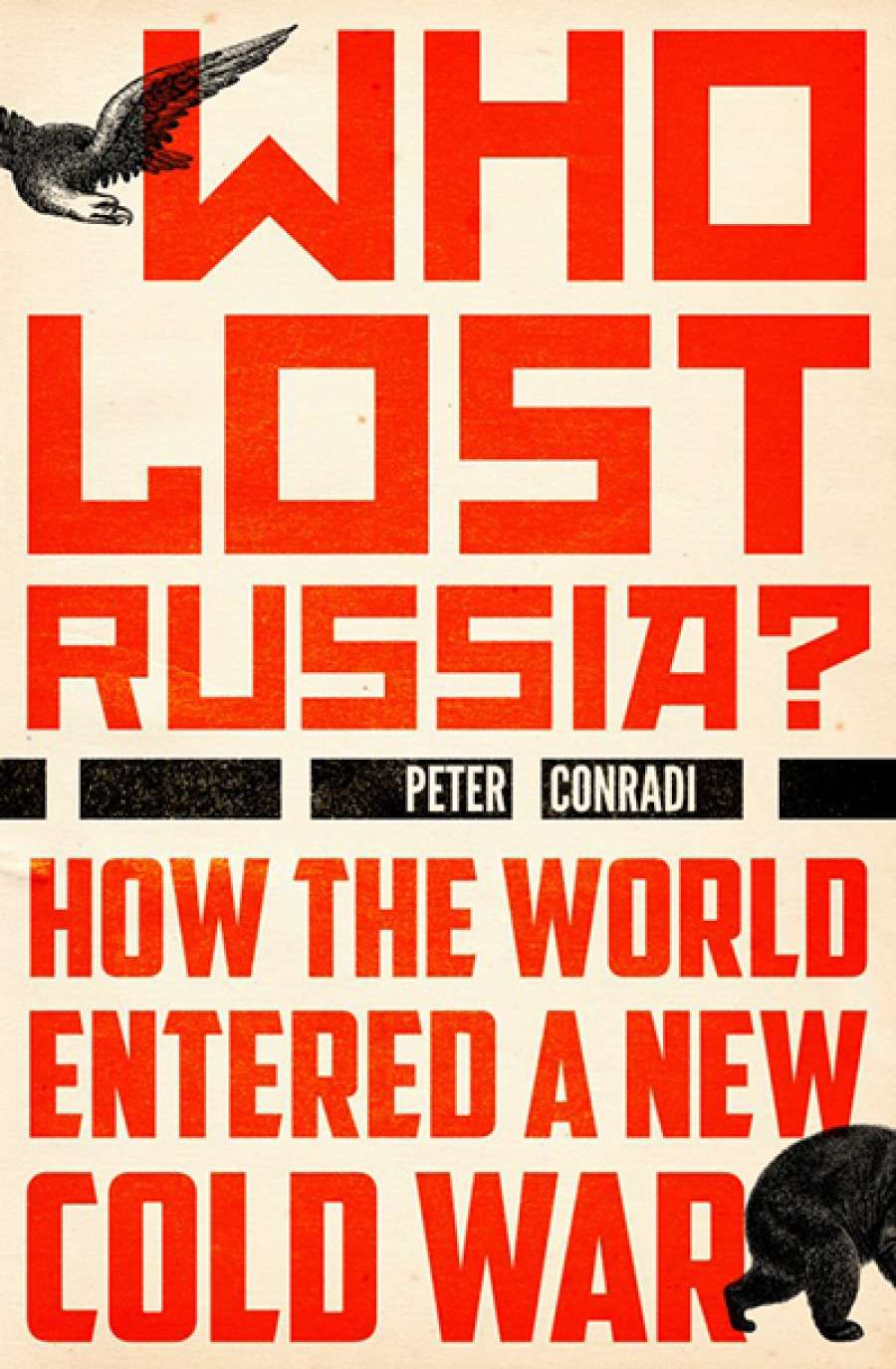
- Free Article: No
- Contents Category: Russia
- Custom Article Title: Iva Glisic reviews 'Who Lost Russia?: How the world entered a new Cold War' by Peter Conradi
- Review Article: Yes
- Online Only: No
- Custom Highlight Text:
Donald Trump’s rise to the presidency has redefined many features of US politics, not the least of which has been the nation’s relationship with its former Cold War nemesis. ‘Wouldn’t it be nice,’ Trump asked while campaigning, ‘if we actually got along with Russia?’
- Book 1 Title: Who Lost Russia?
- Book 1 Subtitle: How the world entered a new Cold War
- Book 1 Biblio: OneWorld, $38.99 hb, 384 pp, 9781786070418
In this context, Peter Conradi’s new book – Who Lost Russia? How the world entered a new Cold War – is timely. The current foreign editor of The Sunday Times in London, Conradi served as a Reuters correspondent to Moscow in the late 1980s and early 1990s, as the Soviet Union collapsed. Returning to a ‘very different’ Moscow in 2016, he seeks to explain how, over the past quarter- century, the prospect of meaningful cooperation between Russia and the West has gradually been lost. Taking its title from a 1992 memo by Richard Nixon that forewarned of this very outcome, this is a ‘story of high hopes and goodwill but also of misunderstandings and missed opportunities’. Across a rapid-fire series of chapters, Conradi recounts all the key events: the dissolution of the Soviet Union; the presidency of Boris Yeltsin (1991–99); the economic chaos of the 1990s; the process of privatisation, and the associated rise of super-rich oligarchs on the one hand, and widespread poverty on the other; Putin’s emergence and ascendancy; the commodity-fuelled economic boom of the 2000s; and, of course, the wars in Chechnya, Georgia, and Ukraine. Intersecting this chronology are descriptions of various discrete episodes that strained Russia’s relationship with the West, including the eastward enlargement of NATO, the UN-defying bombardment of Yugoslavia, the invasion of Iraq, and diplomatic clashes over colour revolutions in Russia’s neighbouring countries. The book also considers moments when the prospect of cooperation was raised, such as in the aftermath of 9/11.
 President John F. Kennedy meeting with Nikita Khrushchev in Vienna, 1961
President John F. Kennedy meeting with Nikita Khrushchev in Vienna, 1961
(John F. Kennedy Presidential Library and Museum)
Specialists might well ask for more robust analysis than Conradi’s approach permits. The book draws almost exclusively on English language sources and interviews with political élites; it does little to challenge the familiar narrative. The sequence of events is well-known, as is the overall reading of Russia–US relations since the dissolution of the Soviet Union: America’s triumphalism and its dismissive treatment of Russia as a vanquished foe engendered a sense of resentment that, as Moscow gained economic strength and political confidence, ultimately gave way to attempts at vengeance. Conradi’s play-by-play leaves little room for analysis, and his shotgun approach to storytelling flattens complex historical phenomena. Yeltsin, for example, comes off as a well-intentioned reformer, while debates over the resurgence of ultranationalist tendencies in Ukraine are presented as mere products of Russian propaganda. Elsewhere, the book reaches for the characterisation of armed conflicts in post-socialist states as outcomes of ancient hatred, a notion that historians have repeatedly exposed as a journalistic platitude that reduces complex political, social, economic, historical, and geopolitical factors to orientalist stereotypes. Ultimately, this lack of nuance makes for a frustrating reading experience.
 President Bill Clinton plays the saxophone presented to him by Russian President Boris Yeltsin in 1994 (photograph by Bob McNeely, Wikimedia Commons)
President Bill Clinton plays the saxophone presented to him by Russian President Boris Yeltsin in 1994 (photograph by Bob McNeely, Wikimedia Commons)
For the most part, the book is framed by a well-worn perception that twenty-first century relations between Russia and the West continue to be defined by conflicting interests and mutual suspicion. Yet Who Lost Russia? is at its most interesting when it complicates this story by observing how the West has bolstered the Russian regime by doing business with it. What should we make of the fact that former German chancellor Gerhard Schröder became chairman of a Gazprom-controlled gas pipeline company within weeks of leaving office in 2005, or that so many Western national banks have provided haven for the wealth siphoned from Russia by countless oligarchs? These episodes, though underexplored, provide a foundation for Conradi to consider what he refers to as ‘what aboutism’, by which Russian authorities deflect criticism by highlighting instances of Western hypocrisy. Yes, political prisoners have died in Russia, but what about Guantánamo Bay? If NATO can initiate humanitarian war, Russia can also use extraterritorial force to protect its citizens. If the West can so quickly recognise Kosovo’s proclamation of independence, surely it stands as a precedent for Crimea. With this strategy, truth becomes irrelevant, or, in the quoted words of Soviet-born British journalist Peter Pomerantsev: ‘Putin doesn’t need to have a more convincing story, he just has to make it clear that everyone lies, undermine the moral superiority of his enemies and convince his people there is no alternative to him.’
Although it ultimately does more to catalogue than to unpack its subject matter, Who Lost Russia? concludes on an important note: ahead lies an era that will be shaped both by the Trump presidency and, almost certainly, also by a fourth presidential term for Vladimir Putin in 2018. In this new era, old questions of who lost Russia or whether there might be another Cold War are distracting. Instead, the challenge is to devise a political grammar by which contemporary reality can be properly articulated.


Comments powered by CComment